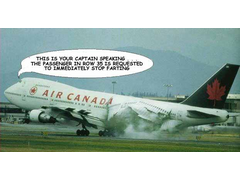

Rescued attachment fartin.jpg

WHAT the bloody hell happened there then?????????????
I hope thats a photo shop jobbie

Of course its a photoshop thing. You dont think you get speach bubbles in real life do you???

To be serious... 


I believe that it was an experiment to work out what happened when a bomb goes off in the luggage compartment - they pressurised the cabin a bit as
well.
It doesn't take much imagination to work out what would happen at 50,000 feet...
David
Ahhhh.
I see!
I was wondering because one of my slightly stranger interests is air crash investigation, and Air Canada never had a report of any 747 having an
accident............but that would explain it!
You only have to read the AAIB report on the Lockerbie disaster to realise what a bomb does in the cargo hold. It was certainly not as big a blast as
on that one pictured above.
quote:
Originally posted by NS Dev
WHAT the bloody hell happened there then?????????????
I've looked carefully though and I can't see any brown stuff exiting the side of the plane
(Guess some did probably exit the pilot though)
From the following website: http://www.aerospaceweb.org/question/planes/q0076.shtml
Quote: The true genesis of this picture can be found at Jez's Aviation Picture Gallery (link no longer available). Apparently the aircraft shown
in the "back half" of the disintegrating 747 was in reality a retired Air France 747-100 used for experiments by the British Defence
Evaluation and Research Agency (DERA).
In particular, the fuselage was pressurized and subjected to four explosive detonations to determine how much damage such charges could do to an
airplane in flight. This research was done in response to the Pan Am bombing over Lockerbie Scotland in 1988 which brought down the aircraft killing
all aboard and several on the ground. The research also evaluated different types of blast protection that could be used to improve the survivability
of passenger airliners in the event of future terrorist bombings.
In terms of our discussion, the following photos illustrate the effect of the explosive charges on the aircraft fuselage.
The third still image is clearly familiar, and it is obvious that some skillful photo editor cleverly superimposed this picture over that of a landing
Air Canada 747 to produce the infamous forgery that we've all come to know and love. But even though the forgery has been exposed, my hat goes
off to the perpetrator who did an exceptionally good job of merging those two photos. Kudos!

